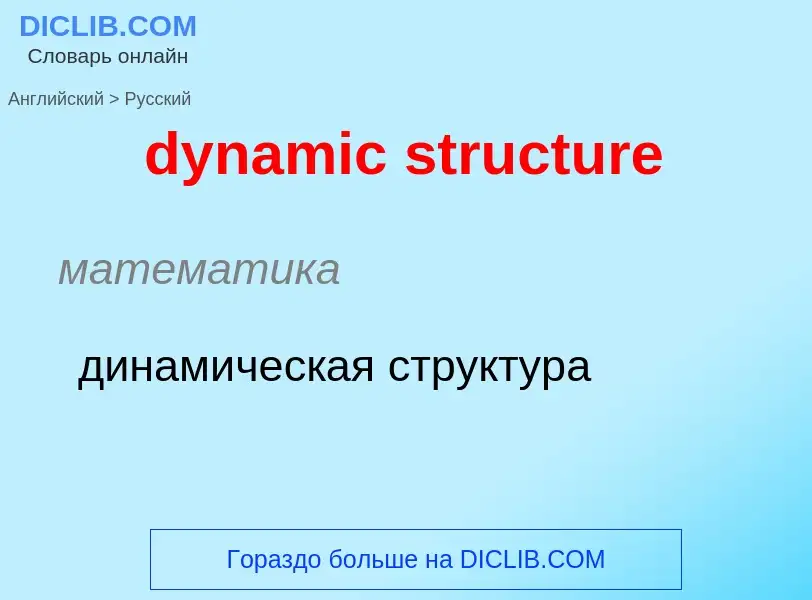Tradução e análise de palavras por inteligência artificial ChatGPT
Nesta página você pode obter uma análise detalhada de uma palavra ou frase, produzida usando a melhor tecnologia de inteligência artificial até o momento:
- como a palavra é usada
- frequência de uso
- é usado com mais frequência na fala oral ou escrita
- opções de tradução de palavras
- exemplos de uso (várias frases com tradução)
- etimologia
dynamic structure - tradução para russo
математика
динамическая структура
общая лексика
динамическая страница
HTML-документ, содержащий анимированные (с помощью Java-аплетов) элементы изображений
математика
динамический анализ
строительное дело
динамический расчёт
расчёт на динамическую нагрузку
Definição
Wikipédia
A space elevator, also referred to as a space bridge, star ladder, and orbital lift, is a proposed type of planet-to-space transportation system, often depicted in science fiction. The main component would be a cable (also called a tether) anchored to the surface and extending into space. An Earth-based space elevator cannot be constructed with a tall tower supported from below due to the immense weight - instead, it would consist of a cable with one end attached to the surface near the equator and the other end attached to a counterweight in space beyond geostationary orbit (35,786 km altitude). The competing forces of gravity, which is stronger at the lower end, and the upward centrifugal force, which is stronger at the upper end, would result in the cable being held up, under tension, and stationary over a single position on Earth. With the tether deployed, climbers (crawlers) could repeatedly climb up and down the tether by mechanical means, releasing their cargo to and from orbit. The design would permit vehicles to travel directly between a planetary surface, such as the Earth's, and orbit, without the use of large rockets.
The concept of a tower reaching geosynchronous orbit was first published in 1895 by Konstantin Tsiolkovsky. His proposal was for a free-standing tower reaching from the surface of Earth to the height of geostationary orbit. Like all buildings, Tsiolkovsky's structure would be under compression, supporting its weight from below. Since 1959, most ideas for space elevators have focused on purely tensile structures, with the weight of the system held up from above by centrifugal forces. In the tensile concepts, a space tether reaches from a large mass (the counterweight) beyond geostationary orbit to the ground. This structure is held in tension between Earth and the counterweight like an upside-down plumb bob. The cable thickness is adjusted based on tension; it has its maximum at a geostationary orbit and the minimum on the ground.
Available materials are not strong and light enough to make an Earth space elevator practical. Some sources expect that future advances in carbon nanotubes (CNTs) could lead to a practical design. Other sources believe that CNTs will never be strong enough. Possible future alternatives include boron nitride nanotubes, diamond nanothreads and macro-scale single crystal graphene.
The concept is applicable to other planets and celestial bodies. For locations in the solar system with weaker gravity than Earth's (such as the Moon or Mars), the strength-to-density requirements for tether materials are not as problematic. Currently available materials (such as Kevlar) are strong and light enough that they could be practical as the tether material for elevators there.

![Mars]] vs [[Moon]] [[gravity]] at [[elevation]] Mars]] vs [[Moon]] [[gravity]] at [[elevation]]](https://commons.wikimedia.org/wiki/Special:FilePath/Earth vs Mars gravity at elevation.webp?width=200)
![[[Carbon nanotubes]] are one of the candidates for a cable material<ref name="physorg_obayashi"/> [[Carbon nanotubes]] are one of the candidates for a cable material<ref name="physorg_obayashi"/>](https://commons.wikimedia.org/wiki/Special:FilePath/Kohlenstoffnanoroehre Animation.gif?width=200)

![Phobos]] Phobos]]](https://commons.wikimedia.org/wiki/Special:FilePath/Space elevator Phobos.jpg?width=200)
![[[Konstantin Tsiolkovsky]] [[Konstantin Tsiolkovsky]]](https://commons.wikimedia.org/wiki/Special:FilePath/Константин Циолковский.jpg?width=200)
![When a request to a dynamic web page or resource is made, the [[application server]] processes the request using its server-side language. When a request to a dynamic web page or resource is made, the [[application server]] processes the request using its server-side language.](https://commons.wikimedia.org/wiki/Special:FilePath/2013vmvClientServer.png?width=200)
